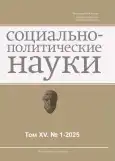Aspects of natural theology in the development of knowledge (XVII–XIX centuries)
- Authors: Devyatova S.V.1, Kazaryan V.P.1
-
Affiliations:
- Lomonosov Moscow State University
- Issue: Vol 15, No 1 (2025)
- Pages: 164-170
- Section: Ontology and theory of cognition
- URL: https://journals.eco-vector.com/2223-0092/article/view/679182
- DOI: https://doi.org/10.33693/2223-0092-2025-15-1-164-170
- EDN: https://elibrary.ru/JWHTQV
- ID: 679182
Cite item
Abstract
The article is devoted to the consideration of the most important foundations and elements of natural theology. Largely due to the scientific revolution of the 17th century, natural theology, which replaced scholasticism, was very popular in Christian Europe in the 17th and 18th centuries. The formation of a holistic Christian worldview during this period was associated with the development of scientific ideas about the world. Many scientists and theologians, seeing the ultimate goal of knowledge of the universe in strengthening the sense of admiration for the wise and rational Creator and reverence for him, found in scientific data confirmation of the existence and providence of God. In this respect, natural theology represented the first form of real integration of Christianity and science.
Keywords
Full Text
About the authors
Svetlana V. Devyatova
Lomonosov Moscow State University
Author for correspondence.
Email: welt1936@yandex.ru
SPIN-code: 6050-8774
Dr. Sci. (Philos.), Рrofessor, Department of Philosophy
Russian Federation, MoscowValentina P. Kazaryan
Lomonosov Moscow State University
Email: kazaryanvp@mail.ru
SPIN-code: 8201-4661
Dr. Sci. (Philos.), Professor, Department of Philosophy
Russian Federation, MoscowReferences
- Avgustin Avrelij. The confession. Abelyar P. The story of my disasters. Moscow: Republic, 1992. 335 p.
- Arago F. Biographies of famous astronomers, physicists and geometers. Moscow–Izhevsk: NIC RXD, 2000. Vol. 1. 496 p.
- Barbur I. Religion and science: history and modernity. Moscow: BBI, 2000. 430 p.
- Bobrov Е.G. Carl Linnaeus. Leningrad: Nauka, 1970. 286 p.
- Bruk D.X. Science and religion: historical perspective. Moscow: BBI, 2004. 347 p.
- Kanaev I.I. Georges Louis Leclerc de Buffon. Moscow; Leningrad: Nauka, 1966. 266 p.
- Kepler I. About hexagonal snowflakes. Moscow: Nauka, 1982. 192 p.
- Paskal B. Thoughts on religion. Мinsk; Moscow: Harvest; АСТ, 2001. 223 p.
- Predtechenskij E.A. Johannes Kepler. In: Copernicus, Galileo, Kepler, Laplace and Euler, Quetelet. N.F. Boldyrev (ed.). Chelyabinsk: Ural, 1997. 456 p.
- Engelgardt M.A. William Garvey. In: Garvey, Jenner, Cuvier, Pirogov, Virchow. N.F. Boldyrev (ed.). Chelyabinsk: Ural LTD, 1998. 400 p.
- Calloway K. Natural Theology in the Scientific Revolution. London; New York: Routledge, 2014. 224 р.
- Hall A.R. Henry More and the Scientific Revolution. Second edition. Cambridge: Cambridge University Press, 2002. 320 р. (Cambridge Science Biographies)
- Mandelbrote S. The uses of Natural Theology in seventeenth-century England. Science in Context. 2007. Vol. 20. No. 3. Рp. 451–480.
- Ott W. Causation and laws of nature in early modern Philosophy. Oxford: Oxford University Press, 2009. 260 р.
- Peterfreund S. Turning points in Natural Theology from Bacon to Darwin: The way of the argument from design. Basingstoke: Palgrave Macmillan, 2012. 133 р.
- Raven С. John Ray, Naturalist: His life and works. Cambridge. Cambridge University Press, 2009. 528 р.
Supplementary files








